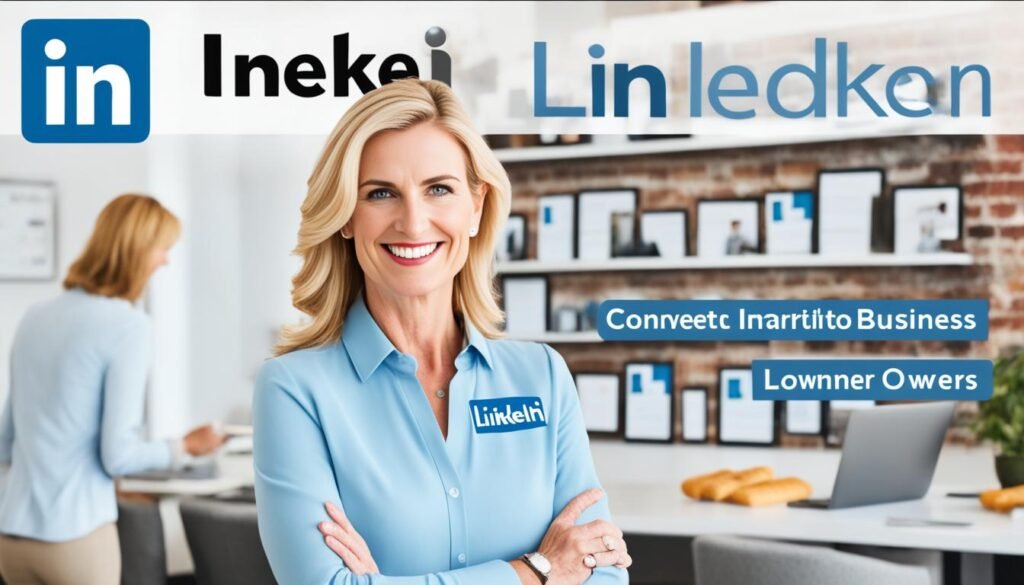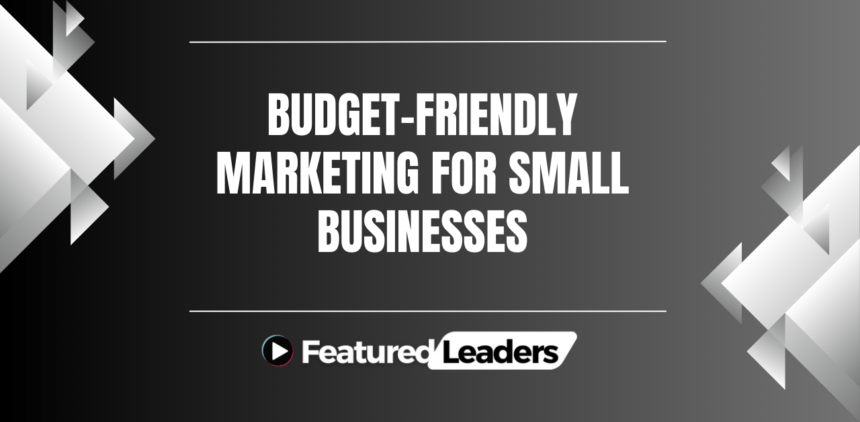Small businesses often face the challenge of promoting their brand on a tight marketing budget. However, there are plenty of low-cost marketing strategies, affordable tactics, and cost-effective promotional ideas that can help you grow your business without breaking the bank.

In this article, we will explore a variety of budget-friendly advertising methods and inexpensive marketing techniques that are perfect for small businesses on a budget.
Key Takeaways:
- Low-cost marketing strategies can help small businesses grow their brand without spending a fortune.
- Affordable marketing tactics and cost-effective promotional ideas are available for businesses with tight budgets.
- Small business marketing on a budget is achievable with the right approach and creative utilization of resources.
- Implementing economical marketing approaches and cheap marketing strategies can yield significant results.
- Consider leveraging free tools and platforms to maximize marketing potential.
Create a Free Google My Business Account
One of the most effective free marketing strategies for local businesses is to create a Google My Business account. This allows your business to show up on Google Maps, the local section of Google Search, and the Knowledge Panel for branded searches. By optimizing your Business Profile and verifying ownership, you can improve your visibility on Google and attract more local customers.
A Google My Business account is essential for local business marketing. It provides valuable online visibility for your business and helps potential customers find you easily through local search optimization. By showcasing your business on Google Maps, customers can get directions and locate you effortlessly.
Moreover, appearing on the Knowledge Panel for branded searches adds credibility to your business. The Knowledge Panel showcases essential information about your business, including contact details, operating hours, customer reviews, and photos.
Creating a Google My Business account is simple. Just follow these steps:
- Visit the Google My Business website.
- Click on the “Start Now” button.
- Sign in to your Google account or create a new one.
- Enter your business information, including the name, address, phone number, and website.
- Verify your ownership of the business through the verification process. This may involve receiving a verification code by mail or phone call.
- Optimize your Business Profile by adding photos, updating your business hours, and providing relevant information about your products or services.
Once you’ve created and verified your Google My Business account, you’ll have access to a range of features that can boost your online presence:
- Respond to customer reviews and engage with your audience.
- Upload photos that showcase your products, services, and ambiance.
- Monitor insights and analytics to understand how customers are finding and interacting with your business.
- Use Google Posts to share updates, promotions, and events directly on your Business Profile.
By leveraging the power of Google My Business, you can strengthen your local business marketing efforts and maximize your online presence. It’s a simple and effective way to connect with potential customers and drive more foot traffic to your store or website.
Post and Engage on Social Media
Social media platforms provide a fantastic opportunity for small businesses to engage with their audience, build a community, and promote their brand. By leveraging the power of social media marketing, you can effectively showcase your brand personality and establish trust with your followers. Here are some strategies to maximize your social media presence:
Promote Your Blog
Use social media as a platform to share and promote your blog posts. This will help drive traffic to your website and establish your business as a trusted source of valuable information. Whether you’re sharing industry insights, how-to guides, or case studies, make sure to create engaging and shareable content that resonates with your target audience.
Engage with Your Followers
Take the time to engage directly with your followers on social media. Respond promptly to comments, answer questions, and acknowledge feedback. By actively participating in conversations, you show your audience that their opinions and concerns matter, fostering a sense of community and loyalty.
Run Polls and Seek Feedback
Running polls on social media is a great way to encourage follower interaction and gather valuable insights. Use polls to ask for feedback on product ideas, marketing campaigns, or even customer preferences. This not only shows that you value your audience’s opinions but also provides you with valuable market research to inform your business decisions.
Tip: Building a community through social media engagement involves genuine interaction and listening to your audience. Remember, it’s not just about promoting your products or services – it’s about building relationships and fostering trust.
Create Quick Info-Packed Posts
Short, informative posts are a great way to provide bitesize content to your audience. Share tips, industry news, or interesting statistics related to your business. These quick posts can be easily consumed and shared, increasing your brand visibility and establishing your authority in your field.
Social media marketing is all about consistency and active participation. Regularly post content, engage with your followers, and encourage user-generated content such as reviews or testimonials. Building a strong social media presence takes time and effort, but the rewards in terms of brand awareness and customer loyalty are well worth it.
Now, let’s take a look at some examples of small businesses that have successfully utilized social media marketing to build their brand:
| Business | Social Media Platform | Approach |
|---|---|---|
| Marvel Studios | Engaging with followers through behind-the-scenes content, fan art features, and interactive Q&A sessions. | |
| Wendy’s | Showcasing a witty and sassy brand personality, engaging in humorous exchanges with followers, and leveraging trending topics. | |
| REI | Sharing outdoor adventure stories, user-generated content, and providing valuable tips and resources for outdoor enthusiasts. |
By analyzing these successful examples, you can gain inspiration for your own social media marketing strategy, tailoring it to suit the unique needs and personality of your small business.
Tag People and Brands on Social Media
One effective way to increase your organic reach and brand exposure on social media is by tagging loyal customers, brand evangelists, neighboring businesses, and vendors in your posts. By tagging relevant individuals and businesses, you not only extend your reach but also attract more followers and potentially acquire new clients.
Encouraging your followers to tag your business in their posts can also expand your brand’s visibility. When customers tag your business, their network becomes exposed to your brand, creating opportunities for new connections and potential customers.
The power of user-generated content should not be underestimated. When users tag your business or create content about your product or service, it can greatly impact your brand’s visibility and growth. User-generated content acts as social proof and builds trust among your target audience, ultimately contributing to the success of your marketing efforts.
Utilizing social media tagging strategically can help you maximize your brand’s exposure and bring organic growth to your business.
Use Hashtags
Incorporating hashtags into your social media posts can help broaden your reach and reinforce your brand identity. By utilizing hashtags effectively, you can optimize your content for targeted audiences and increase your social media optimization. Here are different types of hashtags and how you can use them to enhance your brand visibility:
Broad Hashtags
Using broad hashtags that are relevant to your industry or niche can help you reach a wider audience. Examples of broad hashtags include #marketing, #fashion, or #food. These hashtags are popular and can attract a large number of users who are interested in those topics. However, competition may be high, so make sure your content stands out.
Trending Hashtags
Trending hashtags are hashtags that are currently popular on social media platforms. They can vary from day to day or even hour to hour. Keep an eye on trending topics and incorporate relevant hashtags into your posts to join the conversation and increase your visibility. Examples of trending hashtags include #MondayMotivation or #ThrowbackThursday.
Specific Hashtags
Specific hashtags target a more niche audience within your industry. These hashtags are more focused and can help you reach people who are specifically interested in certain topics or resources. For example, if you run a fitness blog, you can use hashtags like #workouttips or #healthyrecipes to attract users looking for fitness advice or healthy meal ideas.
Location-Based Hashtags
Location-based hashtags are particularly useful if your business targets a specific geographic area. By incorporating local hashtags into your posts, you can attract users in your area who are interested in local businesses, events, or news. For example, if you own a restaurant in Los Angeles, you can use hashtags like #LAfoodie or #LosAngelesEats to target local food enthusiasts.
Custom Hashtags
Create custom hashtags that are unique to your brand to enhance your brand identity and encourage user-generated content. Custom hashtags can help you monitor user engagement and track the success of specific campaigns or events. Make sure your custom hashtags are relevant, memorable, and easy to spell. For example, Coca-Cola uses the custom hashtag #ShareACoke to encourage consumers to share their experiences with the brand.
When using hashtags, it’s important to strike a balance between using popular hashtags to reach a wider audience and using more specific hashtags to target your ideal customers. Additionally, make sure to research and monitor hashtag usage to stay up-to-date with trending topics and to avoid using hashtags that may be associated with controversial or inappropriate content.
Remember to always check the meaning and context of a hashtag before incorporating it into your social media posts. Using hashtags strategically can help boost your brand’s visibility, increase audience engagement, and ultimately drive more traffic to your social media profiles and website.
| Type of Hashtags | Description |
|---|---|
| Broad Hashtags | Popular hashtags that attract a wide audience. |
| Trending Hashtags | Hashtags that are currently popular on social media. |
| Specific Hashtags | Hashtags targeting a niche audience within your industry. |
| Location-Based Hashtags | Hashtags targeting a specific geographic area. |
| Custom Hashtags | Unique hashtags created for your brand. |
Leverage LinkedIn
LinkedIn is often underutilized as a professional social media site, but it can be a powerful tool for marketing your business. By engaging with connections, sharing valuable content, participating in forums, and encouraging employees to get active, you can build your brand presence and gain trust and respect in your industry. LinkedIn offers a cost-effective way to promote your business to professionals in your field.
Professional Networking
LinkedIn provides a platform for professional networking, allowing you to connect with industry peers, potential partners, and even new clients. By building a strong network of connections and actively engaging with them, you can expand your professional reach and open up new opportunities for collaboration and growth.
Brand Promotion
LinkedIn offers various tools and features to promote your brand effectively. You can create a compelling Company Page that showcases your products or services, share thought-provoking articles and industry insights, and post updates to keep your network informed about your latest developments. This helps establish your brand as a reputable authority in your field.
Employee Engagement
LinkedIn is not just for individuals but also for businesses. Encouraging your employees to create LinkedIn profiles and actively engage on the platform can have a significant impact on your brand’s visibility. When employees share company updates, participate in industry discussions, and showcase their expertise, it not only boosts their professional profiles but also contributes to the overall reputation of your business.
Industry Expertise and Thought Leadership
LinkedIn is an ideal platform for demonstrating your industry expertise and establishing yourself as a thought leader. By sharing valuable content such as articles, whitepapers, and research findings, you can showcase your knowledge and position yourself at the forefront of your industry. This can lead to speaking engagements, media opportunities, and increased recognition within your field.
“LinkedIn is a goldmine for professionals. The platform has helped me connect with industry leaders, gain valuable insights, and establish myself as an industry expert. It’s an essential part of my marketing strategy.” – Sarah Johnson, Marketing Manager at XYZ Company

| Benefits of LinkedIn Marketing | Examples |
|---|---|
| Increased brand awareness | Sharing informative articles and engaging with connections |
| Expanded professional network | Connecting with industry peers and potential partners |
| Enhanced industry reputation | Demonstrating thought leadership through valuable content |
| Employee advocacy | Encouraging employees to engage on LinkedIn |
| Opportunities for collaboration | Building partnerships and connections in your industry |
LinkedIn offers a wealth of opportunities for businesses looking to grow their brand and connect with professionals in their field. By leveraging LinkedIn marketing strategies, you can enhance your professional network, establish yourself as a thought leader, and promote your brand effectively.
Do Local SEO
Local SEO is a crucial strategy for small businesses to gain visibility and compete with larger competitors on search engine results pages. By focusing on location-based keywords, online directories, and neighborhood-specific content, you can improve your local search visibility and increase your chances of appearing in Google’s 3-Pack.
Location-Based Keywords
Optimizing your website with location-based keywords is essential for attracting local customers. Incorporate keywords that are relevant to your business and its location into your website’s content, meta tags, and headings.
Online Directories
List your business in online directories like Yelp, Google My Business, and Bing Places for Business. These directories provide valuable backlinks and increase your business’s online presence, making it easier for potential customers to find you.
Neighborhood-Specific Content
Create and publish content that is specific to your neighborhood or local area. This could include blog posts, articles, or guides that highlight local events, attractions, or news. By providing valuable neighborhood-specific content, you can attract local visitors and establish your business as a trusted resource in the community.
By implementing these local SEO strategies, you can improve your search engine visibility and increase your chances of appearing in Google’s 3-Pack. This prime real estate on search engine results pages can drive significant organic traffic and help your small business thrive.
Develop an Email Marketing Plan
Email marketing is a powerful and cost-effective strategy for small businesses to engage new visitors and maintain relationships with existing customers. By implementing an effective email marketing plan, you can drive customer engagement, increase brand awareness, and boost sales. Here are some key components to consider:
Craft Compelling Subject Lines
Subject lines play a crucial role in grabbing the attention of your email recipients. Use enticing and personalized subject lines that create a sense of urgency or curiosity. Experiment with different approaches to see what resonates best with your audience and drives higher open rates.
Include Compelling Offers
To drive conversions and encourage customer engagement, make sure to include compelling offers in your emails. Whether it’s a discount, promotion, or exclusive content, provide value that entices subscribers to take action. Tailor your offers to meet the needs and preferences of your target audience.
Track Performance and A/B Test
Tracking the performance of your email campaigns is essential to understanding what works and what doesn’t. Utilize email marketing platforms that offer performance tracking features, such as click-through rates and conversion rates. Additionally, perform A/B testing to experiment with different elements in your emails, such as layout, design, and call-to-action, to optimize your results.
Nurture Subscribers
Building long-term relationships with your subscribers is crucial for customer retention and repeat business. Develop a subscriber nurturing strategy that includes sending personalized emails, valuable content, and exclusive offers to keep your audience engaged and satisfied.
Utilize Free Email Marketing Services
There are many free email marketing services available that cater to small businesses. Platforms like MailChimp offer easy-to-use templates, automation features, and analytics to help you streamline your email marketing efforts without breaking the bank.

Incorporating email marketing into your overall marketing strategy can yield significant results in terms of customer engagement, brand loyalty, and revenue generation. By crafting compelling subject lines, including compelling offers, tracking performance, performing A/B tests, nurturing subscribers, and utilizing free email marketing services, you can leverage the power of email to drive business growth.
Create Data-Rich Infographics
Infographics are powerful marketing tools that combine visual elements with informative content, making them highly engaging and shareable. They can attract referral traffic, increase link shares, and enhance brand visibility. However, designing infographics can often be time-consuming and expensive.
Luckily, there are free design tools available that provide the necessary elements to create visually appealing infographics. Canva, Adobe’s free vector kits, and Visme are some popular options that offer a wide range of templates, icons, and fonts to choose from. These tools make it easy for anyone, even those without design experience, to create stunning infographics.
Utilizing Relevant Data Sources
When creating data-rich infographics, it’s important to use accurate and relevant data that adds value to your content. Government sources and reputable organizations like UNICEF often provide data on various topics that can be used in infographics. This not only ensures credibility but also provides your audience with valuable insights and information.
By incorporating data from reliable sources, you can create infographics that educate and engage your audience while establishing your brand as a trusted source of information.
| Data Sources | Description |
|---|---|
| Government Agencies | Government websites often provide data on demographics, economic trends, and industry-specific information. |
| Research Institutions | Institutions like UNICEF, Pew Research Center, and Gallup conduct studies and publish reports that can be used as valuable data sources. |
| Industry Associations | Trade associations and industry-specific organizations often publish research and statistics related to their respective sectors. |
Using reliable data sources not only adds credibility to your infographics but also positions your brand as a thought leader in your industry. This can attract more audience engagement and increase the likelihood of your infographics being shared and linked to by other websites, contributing to your overall link building efforts.
By leveraging free design tools and utilizing relevant data sources, you can create visually appealing and informative infographics that effectively communicate your message, attract referral traffic, and contribute to your overall marketing strategy.
Claim Free Ad Promo Credits
While large-scale ad campaigns may be out of reach for small businesses, there are often discounts and promo codes available for platforms like Facebook and Google Ads. Some web hosting services also offer advertising discounts as part of their membership offerings. Utilizing these promotional opportunities while improving your PPC skills can help you achieve better results and gain audience insights.
Benefits of Ad Promo Credits
- Save money on advertising expenses
- Reach a wider audience without breaking your budget
- Test different advertising strategies without significant financial risk
- Obtain valuable audience insights through ad analytics
By taking advantage of ad promo credits and advertising discounts, small businesses can maximize their marketing efforts and make their budget stretch further. This is especially beneficial for businesses that are just starting out or have limited resources. It allows them to compete with larger competitors and gain valuable exposure without incurring excessive costs.
Improving Your PPC Skills
In addition to claiming ad promo credits, it’s crucial to focus on developing your PPC (pay-per-click) skills. This will help you optimize your ad campaigns and achieve better results. Here are some tips to enhance your PPC skills:
- Thoroughly research your target audience to understand their interests, preferences, and behavior.
- Create compelling ad copy that resonates with your target audience and encourages them to take action.
- Use proper keyword research techniques to select relevant keywords for your ads.
- Regularly analyze your ad performance and make data-driven adjustments to improve conversion rates.
- Stay updated with industry trends and new features offered by advertising platforms to stay ahead of the competition.
By continuously honing your PPC skills, you can make the most out of your ad promo credits and achieve optimal results for your small business.
Comparison Table: Ad Promo Credit Options
| Platform | Promo Offer | Validity |
|---|---|---|
| Facebook Ads | Get $100 in ad credits when you spend $25 | Valid for new advertisers |
| Google Ads | Receive $150 in ad credits when you spend $50 | Valid for new advertisers |
| Web Hosting Services | Get 25% off on advertising credits with hosting subscription | Valid for new and existing customers |
Table: A comparison of ad promo credit options available for small businesses
By leveraging these ad promo credits and discounts, small businesses can effectively market their products or services, drive targeted traffic to their websites, and gain valuable audience insights. It’s a win-win situation that allows small businesses to compete with larger competitors on a more level playing field, all while staying within their budget.
Conclusion
Marketing your small business on a tight budget is not only possible but can also yield significant results. By implementing creative and strategic approaches, you can effectively promote your brand without breaking the bank.
Utilizing free tools and platforms like Google My Business, social media, and LinkedIn allows you to reach a wider audience and build credibility. Implementing local SEO strategies, leveraging email marketing, and creating visually appealing content such as infographics can further enhance your marketing efforts.
Remember to prioritize your resources and maximize their potential. By establishing yourself as an industry expert and utilizing special offers and promotions, you can attract more customers and grow your business. With budget-friendly marketing ideas, you can achieve your goals without compromising on quality or results.
So, step up your marketing game and embrace these low-cost strategies to make the most of your small business marketing on a budget. With the right approach, you can effectively promote your brand, attract customers, and boost your business’s growth.
FAQ
What is Google My Business?
Google My Business is a free platform that allows businesses to create and manage their online presence on Google. It enables businesses to show up on Google Maps, in the local section of Google Search, and in the Knowledge Panel for branded searches.
How can social media help promote a small business?
Social media platforms provide a free way to grow your small business by expressing your brand’s personality, building trust with your audience, promoting blog posts, engaging directly with followers, running polls and requesting feedback, and creating quick informational posts.
How can tagging people and brands on social media benefit a business?
Tagging loyal customers, brand evangelists, neighboring businesses, and vendors on social media can extend your organic reach, attract more followers, and potentially acquire new clients. Encouraging your followers to tag your business in their posts can also expose your brand to their network.
How can hashtags be used effectively in marketing?
Incorporating hashtags into your social media posts can help broaden your reach and reinforce your brand identity. Using a mix of broad and trending hashtags, specific hashtags for resources or advice, and location-based hashtags can optimize your content for targeted audiences. Custom hashtags can also enhance your brand visibility on platforms like Instagram, Twitter, and TikTok.
How can LinkedIn be leveraged for business promotion?
LinkedIn is a professional social media site that can be utilized by actively engaging with connections, sharing valuable content, participating in forums, and encouraging employees to get active. By doing so, you can build your brand presence, gain trust and respect in your industry, and establish yourself as a thought leader.
What is local SEO and how can it benefit a small business?
Local SEO is a free marketing strategy that helps small businesses compete with larger competitors for page one real estate on search engine results. By adding location-based keywords to your website, getting listed in online directories, and publishing neighborhood-specific content, you can improve your local search visibility and increase your chances of appearing in Google’s 3-Pack.
What are some effective practices for email marketing?
Email marketing is a cost-effective way to engage new visitors and maintain relationships with existing customers. Some effective practices include crafting compelling subject lines, including enticing offers, tracking performance, performing A/B tests, nurturing subscribers until they become paying customers, and utilizing free email marketing services like MailChimp.
How can infographics be used in marketing?
Infographics are powerful marketing tools that can attract referral traffic, increase link shares, and enhance brand visibility. Although designing infographics can be expensive, there are free tools like Canva, Adobe’s free vector kits, and Visme that provide the necessary elements to create visually appealing infographics. Utilizing existing data from government sources and organizations like UNICEF can provide relevant content for your infographics.
Are there any ways to advertise on a budget?
While large-scale ad campaigns may be out of reach for small businesses, there are often discounts and promo codes available for platforms like Facebook and Google Ads. Some web hosting services also offer advertising discounts as part of their membership offerings. Utilizing these promotional opportunities while improving your PPC skills can help you achieve better results and gain audience insights.
Can small businesses effectively market their brand on a tight budget?
Yes, marketing on a tight budget is possible for small businesses with creative and strategic approaches. By leveraging free tools and platforms like Google My Business, social media, and LinkedIn, implementing local SEO strategies, utilizing email marketing, creating visual content like infographics, and taking advantage of special offers and promotions, small businesses can effectively market their brand without spending a fortune.






